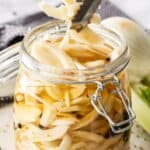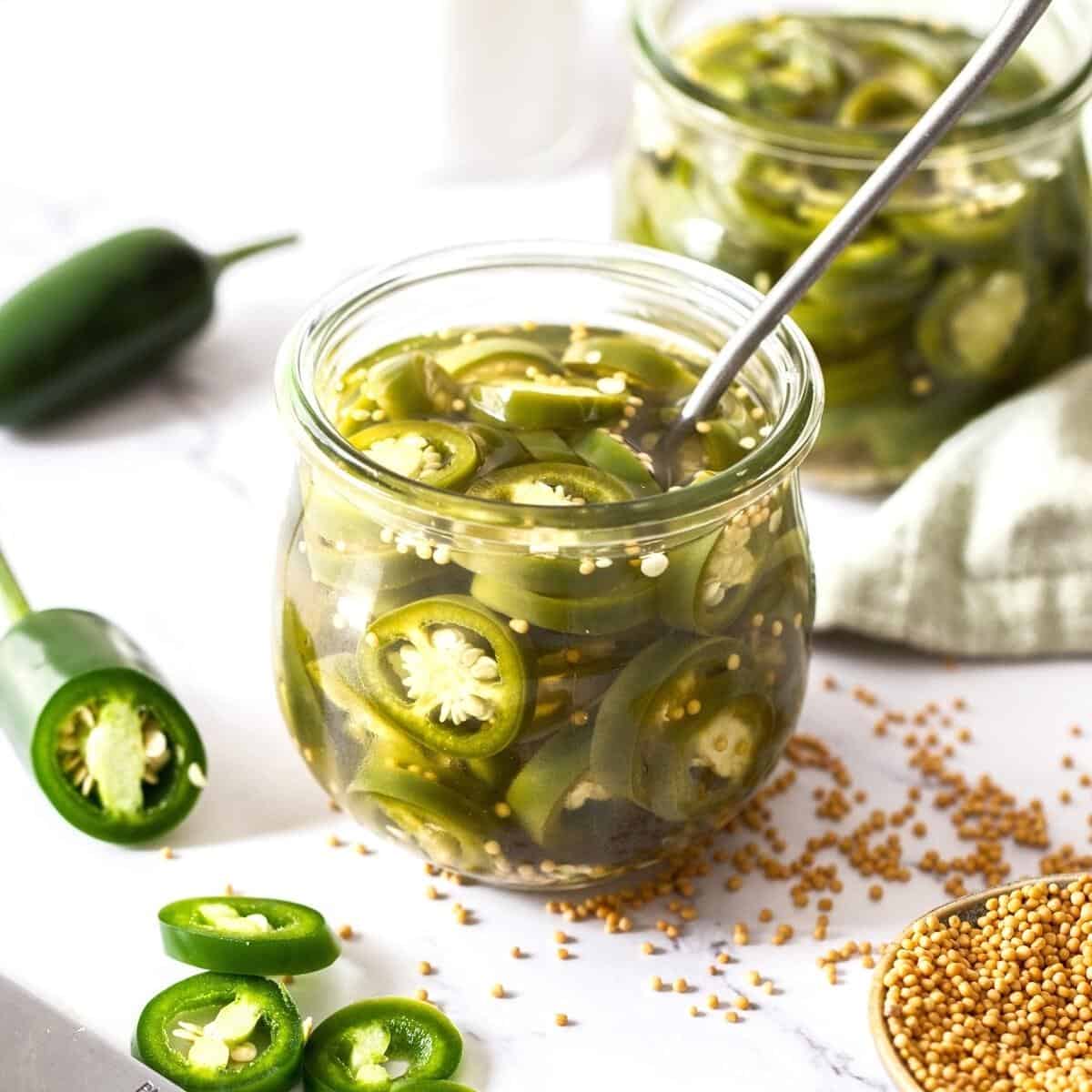You will find many ways to enjoy this easily made, quick Pickled Fennel. Minimal effort is required to make these crunchy, tangy pickles that are ideal for pairing with meat, fish or poultry. As well, they are a great addition to a grazing platter, salads or sandwiches for additional flavour and texture! You just add the thinly sliced fennel to a sterilised jar and pour over the brightly flavoured brine. Seal the jar, refrigerate the pickles, and after a short time, they are ready to eat. It doesn’t come much better or easier than that!

Why you’ll love this recipe:
When fennel is abundant at the height of the season, I like to make the best use of the produce. Fennel is at its best during the cooler months, and this easy pickle is a great way to set some aside to enjoy in the weeks ahead.
A quick pickle can really transform the taste and texture of many vegetables. This crisp Pickled Fennel becomes an incredible flavour booster for so many dishes!
You will love this Pickled Fennel because:
- It is quickly and easily made.
- You will have the satisfaction of knowing that you have made them yourself and know exactly what they contain.
- It is the perfect way to preserve an ingredient at the height of the season and enjoy it throughout the weeks ahead.
- They are perfect for the novice or experienced cook alike. If you have not previously made your own pickles, this is a great place to start.
- Many dishes will benefit from the addition of this tangy pickle, and they also make a great edible gift.
Ingredients in this recipe:
Please see the recipe card further along in the post for exact quantities of ingredients and the full method.

Fennel bulb – fresh fennel has a crisp texture and a mild aniseed flavour. For the best result, choose small to medium bulbs that feel firm to the touch. The flesh should be white and the fronds a bright green. Avoid those with blemishes or yellowing fronds.
Vinegar – for pickling, we use white vinegar with an acidity of 5%, but you can use white wine vinegar or apple cider vinegar if you prefer.
Water – for this quick pickle, we add a small amount of water to mellow the brine. Ensure you use filtered water, as water that contains chlorine can alter the taste of the pickles and may cause the brine to be cloudy.
Salt – ensure you use coarse cooking salt or sea salt, as regular table salt is stronger and may contain anti-caking agents which would make the brine cloudy.
Sugar – regular granulated sugar works fine. It helps to preserve the pickles and balances the flavour. Caster/Superfine sugar is also suitable to use.
Black pepper – whole black peppercorns add a spicy flavour.
Red chilli pepper flakes – a little heat works well with this Pickled Fennel. Add more to your liking if you wish!
Mustard seeds – we use yellow mustard seeds to add crunch and flavour to the pickling brine.
How To Make Pickled Fennel:
Please see the recipe card further along in the post for exact quantities of ingredients and the full method.

1 – Prepare your fennel:
Trim the top and base of the fennel bulb and discard. Remove any of the outer layers if they are coarse.
Cut in half lengthways and then in half again. Remove the core from each quarter of fennel.
Cut the fennel downwards into thin strips.
2 – Make your pickling brine:
Add the ingredients for the pickle brine to a small saucepan.

3 – Bring the pickling brine to a boil:
Stir over medium heat to dissolve sugar, then bring to the boil. Remove from the heat.
4 – Add to your jar:
Add the fennel to your jar, top with the pickling liquid and seal.
Allow to cool before refrigerating. We recommend that you wait for a minimum of 12 hours before eating.

Tips for success and FAQs:
When making your own pickles and preserves, it is important to sterilise the jars you will store them in. This information is included in the recipe. As well, I recommend that you use a jar with a wide opening to make it easier to fill with the sliced fennel.
Ensure your fennel is fresh and firm – this will give your pickles the best taste and texture.
When properly prepared and stored, the Pickled Fennel will last in the fridge for up to 3 weeks. They will get softer the longer you keep them.
For the best result, it is best to leave them for 12-24 hours to let the flavours develop and the vinegar to mellow.
Absolutely, this recipe can be adapted to make a smaller or larger batch, depending on the quantity you require.
I have used white vinegar with an acidity of 5%, but you can use white wine vinegar or apple cider vinegar if you prefer.
Variations and substitutions:
Yellow mustard seeds – you can use brown if that’s what you have on hand. The yellow seeds are milder, and the brown spicier.
White vinegar – if you prefer, you can use white wine vinegar or apple cider vinegar.

Serving suggestions:
This quickly and easily made Pickled Fennel adds crispy texture and vibrant flavour to many dishes. Some suggestions for serving them are:
- They are a great accompaniment to fish dishes.
- Add them to an antipasto selection.
- Add some to a green salad for additional texture and flavour.
- They are perfect served alongside more robust foods, such as braised lamb shanks, to cut through the richness.
- Top Crostini with some sour cream, flaked hot smoked salmon and Pickled Fennel. Finish with a sprinkle of freshly ground black pepper.
- Give a jar as a gift. You can even print out your own label, as seen in the photos! Simply right-click and save the image below to print out.

I hope you will give this delicious Pickled Fennel a try. Be sure to let me know in the comments below – I would love to know what you think!
Alex xx
More delicious recipes for you to try:
Stay in touch!
Follow me on Facebook, Pinterest and Instagram and subscribe to my newsletter.

Pickled Fennel
Equipment
- 1 x 800ml (27 fluid oz) Jar
Please note:
For accuracy, when weights are provided, we recommend weighing your ingredients. This will produce the best results. All oven temperatures listed are for fan forced.
Ingredients
- 400 g (14 oz) fennel – prepared weight, approx. 1 large bulb. See Note 1
- 2 teaspoon sea salt See Note 2
- 1 cup (250 ml) white vinegar See Note 3
- ¾ cup (180 ml) water See Note 4
- 2 ½ tablespoon sugar See Note 5
- 1 teaspoon whole yellow mustard seeds
- 1 teaspoon whole black peppercorns
- ¼ teaspoon red chilli pepper flakes
Instructions
To Sterilise the Jars:
- Sterilise the jar or jars you'll be using to store the pickles. Choose glass jars with an airtight, metal lid and ensure they have been washed by hand in hot soapy water then rinsed well. Check that the metal lids do not have rubber inserts – if they do, allow them to air dry, instead of placing in the oven.Preheat the oven to 130 Degrees C (270 F) and place the jars in the oven for 15-20 minutes. Keep the jars warm.
For the Pickled Fennel:
- Wash and dry the fennel. Trim the top and base of the fennel bulb and set aside- keep these for stocks or sauces. Remove any of the coarse outer leaf of the bulb.
- Cut the fennel in half lengthways and then in half again. Remove the core from each piece of fennel.
- Using a sharp knife or a mandolin cut the fennel into thin strips – I aim for ¼ cm.
- In a small non-reactive saucepan, combine the water, vinegar, sugar and seasonings. Stir over medium heat to dissolve the sugar, bring to the boil and remove from the heat. (See Note 6).
- Add the fennel to the sterilised jar, top with the pickling liquid and seal with the lid immediately.
- Allow the jar to cool on your bench before placing in the refrigerator.
- The Pickled Fennel can be consumed once cool, but it is best to leave for 12-24 hours for the flavours to develop.
Notes
- Fennel: ensure your fennel is fresh and crisp.
- Cooking sea salt: ensure you use cooking salt or coarse sea salt. Regular table salt may contain anti-caking agents and is much stronger.
- Vinegar: I have used white vinegar that is 5% in acidity. You can also use apple cider or white wine vinegar – just ensure the acidity level is 5%.
- Water: ensure you use filtered water, as water that contains chlorine can alter the taste of the pickles.
- Tablespoon: we use a standard Australian tablespoon which is 20 ml (4 teaspoons).
- Non-reactive saucepans: are those which are ceramic, stainless steel, glass or enamelled cookware. Copper, iron and aluminium pans are reactive. Acidic foods, such as vinegar or lemons, may take on a metallic taste and discolour if cooked in such pans.
- Storage: once the jars have cooled, store the pickles in the fridge for up to three weeks. This is a quick pickle recipe not designed for long term canning.
- Nutritional information: is based on the entire jar, and includes the pickling liquid.
Nutrition Estimate:
Nutritional Disclaimer:
The nutritional information is an estimate only, and is derived from online calculators. For accurate results, we recommend calculating the nutritional information based on the ingredients and brands you use.















Jacqueline D.
We love fennel here in Italy! I was so happy how my pickled fennel turned out. Nice to have a different way to prepare fennel!
Alexandra Cook
This makes me so happy to hear, Jacqueline! Thank you 🙂
Alex xo
Conchetta
I started putting pickled fennel on my charcuterie tray. Yum- So tangy, crispy and different. Love this easy recipe
Alexandra Cook
Hi Conchetta!
Thanks so much for giving this recipe a try, and I am so pleased that you enjoyed it.
A perfect addition to a charcuterie tray 🙂 Alex xo